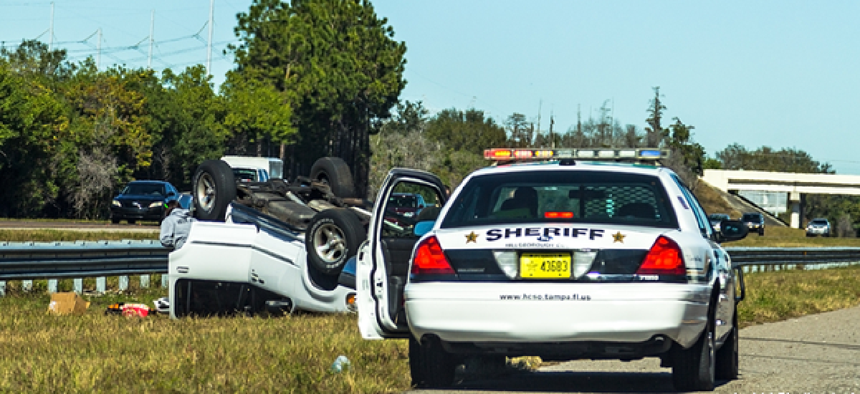Getting real-time crash data to responders


Connecting state and local government leaders
Public safety answering points in California can get real-time crash notifications through an agreement between a cloud-based emergency response platform and General Motors’ OnStar emergency system.
Public safety answering points (PSAPs) in California can get real-time crash notifications through an agreement between a cloud-based emergency response platform and General Motors’ OnStar emergency system.
Announced at the end of March, the collaboration between OnStar and RapidDeploy gives 911 call takers in the state immediate data about accidents that they can use to improve response – for instance, dispatching several ambulances to a multi-vehicle pileup.
“For us, it’s about saving lives and protecting property,” said Budge Currier, California’s 911 emergency communications branch manager at the California Governor’s Office of Emergency Services (Cal OES). “That’s our return on investment. We’ll save lives and improve response times.”
The automation replaces a previously manual process, saving time in verbally relaying information and speeding responses. Typically, when call takers at the OnStar dispatch center learn of a vehicle crash, they contact the appropriate PSAP and share information about the accident over the phone.
“This new system will take all of that data that’s associated with the crash – whatever it is that OnStar is sending – and it will put it up in the RapidDeploy cloud-based system automatically,” Currier said. The system gives the dispatch center access “to all that information immediately through that RapidDeploy login that they provide,” Currier said.
OnStar’s Automatic Crash Response technology provides information such as whether airbags deployed, which side of the vehicle has been affected and the likely injuries. That data appears on the PSAP dispatcher’s screen along with RapidDeploy’s RadiusPlus 911 map screen, which shows the location of the incident.
“As soon as the crash occurs, the data will appear for the telecommunicators for the state of California 911 centers … [and] if it’s an electric vehicle, the make, model, color, the precise location,” said Catherine Bishop, senior manager of OnStar Emergency Services. “We’ve all seen the stories on how burdened the nation’s 911 centers are. In many cases, they don’t have time to take the data, and there could be errors in taking it down manually, so we don’t believe that the driving public has been able to benefit as much as they could with the data just because of the cumbersome nature of the transmission.”
RapidDeploy and OnStar integrate through a technical solution that allows the latter to transmit the data between the two solutions’ back ends. OnStar responds to about 200 cases of Automatic Crash Response notifications per month in California.
“As that 911 call taker answers the phone, we are totally integrated with the phone system, so we know the number that’s calling, we know it’s an OnStar number,” RapidDeploy CEO and Cofounder Steven Raucher said. “As they answer the phone, pop! On their screen is all the information about that crash: impact velocity, the number of seatbelts, how many occupants in the car, how many airbags deployed, did the car roll – all that information is on the screen of the call taker,” he said.
Cal OES contracted with RapidDeploy in March to provide the company’s Emergency Data Gateway (EDG) internet of things devices to the state’s 450 PSAPs, which decide individually about adoption. Hosted in the Microsoft Azure Government Cloud and with encrypted IP connectivity from AT&T, EDG is a cigar box-sized device that customers can connect themselves to get the RadiusPlus location app up and running in minutes, Raucher said.
A benefit of its being a cloud-based system, Currier said, is that updates are pushed out automatically.
“If we get halfway through the deployment or even six months from now, somebody comes up with a better way to either display data or interface with the data or whatever, we just simply have to work with RapidDeploy to make the updates,” he said. Once the update is tested, it can be rolled out statewide in minutes.
What’s more, Cal OES can run the additional data it gets from RapidDeploy and OnStar through its analytics platform to uncover new trends. “It’s certainly information we did not have access to prior to this type of solution, so we’re pretty excited about the possibilities there,” Currier said.
The biggest benefit, however, remains the faster response times. “You could imagine how long it takes to relay this kind of information manually and verbally,” he said. “Now it’s completely automated and it populates on the screen and the information is available right there at the dispatcher’s fingertips.”
“If I’m shaving seconds off the call, shaving seconds off the data input and shaving seconds off the response, ultimately we’re probably saving two minutes, and a minute is life or death,” Raucher added.
Currently, this solution works only with vehicles that have OnStar, but Currier said Cal OES has been contacted by a company that supports some of the German car manufacturers. He declined to comment further, as that effort is still pending.
NEXT STORY: Making an impact as a new CIO




